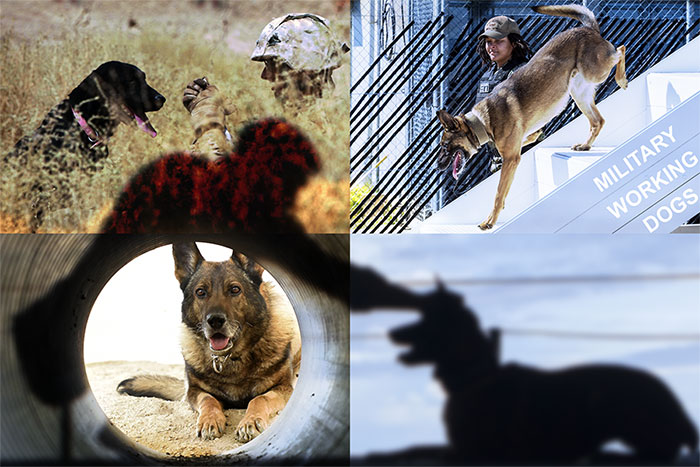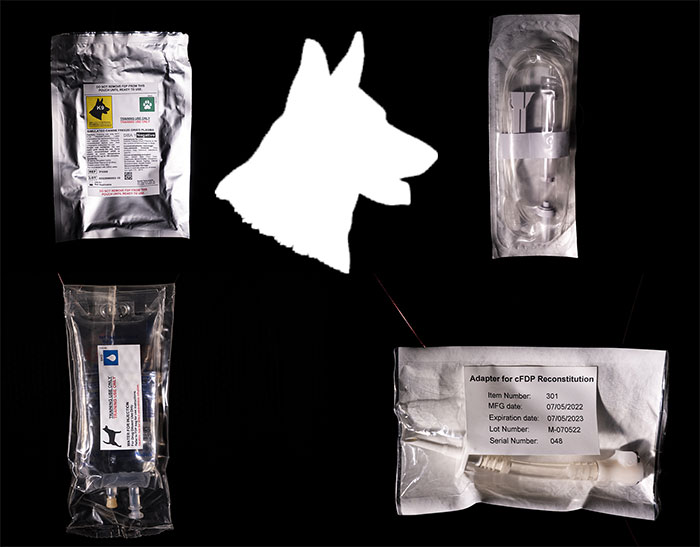USAMMDA works to modernize lifesaving treatment for K-9 partners

Not all Warfighters have only two legs or wear boots, camouflage uniforms, helmets, and body armor. Military Working Dogs (MWD) hold a special and time-honored role in today's military, with the history of human-canine partnerships during war stretching back millennia.
Like household pets, MWDs offer companionship and loyalty. Unlike most household pets, today's MWDs offer frontline military members the added benefit of sniffing out bombs, imminent danger, and opportunity. They are extraordinarily valuable team members in each U.S. military service.
Along with the duties comes the inherent danger of military training and operations. An estimated 4,000 MWDs were injured during the two decades American Warfighters fought in Iraq and Afghanistan, serving alongside America's Soldiers, Sailors, Airmen and Marines. Today, a team with the U.S. Army Medical Materiel Development Activity (USAMMDA) at Fort Detrick, Maryland, is working to answer the vexing problems presented when MWDs are injured and losing blood in combat. The key, they believe, is fielding lifesaving canine blood products that will sustain MWDs at or near the point-of-injury until security is established, the patient is stabilized, and a medevac team can move the MWD to higher echelon of care – the exact same lifesaving measures exercised for humans injured and wounded in combat.
"[Military Working Dogs are] carefully selected, carefully trained, highly capable Warfighters," said Dr. Cliff Snyder, USAMMDA's Warfighter Protection and Acute Care (WPAC) team's Health Science product manager, who has been with USAMMDA since 2003. "Without access to this type of product, some dogs will die that could have survived. Since military dogs work alongside people as members of a team, the loss of a dog means the loss of the function that the teammate provides. Whether the function is detection of explosives, maintenance of security, or otherwise, that function is gone until the canine team member is returned to duty or replaced."
The WPAC team marked recent successes in the K-9 blood products program, receiving 10 canine blood plasma training kits from their industry partner, Mantel Technologies. The WPAC team fielded five of the kits to stakeholders within the Department of Defense, the first major milestone for the approved partnership that began in September of last year.

"Our freeze-dried plasma kit contains sterile water for reconstitution. So, it is as heavy as a volume of blood, which is mostly water anyway," said Snyder, who also served as an Army biochemist from 1982 to 1986. "The logistical advantage is that the kit is stable for at least one year, whereas whole blood, if available under refrigeration, would be useful for a month, at most. [If] a supply of canine freeze-dried plasma kits is available in the field before medevac is called in, medevac might not need to carry the kits, or as many kits."
The K-9 freeze-dried blood plasma program is only one of several lines-of-effort the WPAC team is developing as part of the larger blood products initiatives to treat both canine and human patients. From an operational, logistical, and humanitarian perspective, the WPAC team is working to provide MWDs the same level of care in training and operational environments as their human handlers, according to Snyder. "The canine blood products family of systems is our approach to providing our canine Warfighters the same standard of care that we seek to provide for people – the best care that can be delivered under the circumstances," said Snyder.
USAMMDA hosts five Project Management Offices, including WPAC. The WPAC team is comprised of approximately three dozen Soldiers, Army civilians and contractors. The core mission: to develop and deliver FDA-approved treatment and prevention products that will save and preserve lives. The WPAC mission includes frequent and routine collaboration with a broad group of experts within the DoD, other government agencies, academia, and industry to ensure advanced care of ill and injured Warfighters, including MWDs. The collaborative efforts are reflective of the evolving importance of MWDs and the development of processes to care for them when injured.
The current developments will, ideally, reach Joint-Force veterinarians and frontline medical providers sometime in the next five years. According to Lt. Col. Charles Bane, director of USAMMDA's Force Health Protection division, FDA-approved canine FDP kits, once fielded, will give dog handlers, medics, and corpsmen a much-needed advantage when treating time-critical care cases before canine patients can be evacuated to a higher-level care.
"It has been quite a while since I deployed with working dogs, but MWDs and Multipurpose Canines are typically widely dispersed with a very low likelihood of veterinary personnel being at the point of injury," said Bane, himself a Doctor of Veterinary Medicine. "So, it would be up to the handler or medic at the frontline to initially treat canine injuries. As the veterinarian for a Special Forces Group, I prepared pre-deployment medical kits for the handlers, which certainly did not include any kind of canine blood product at that time."
With the focus today on developing care technologies, treatments, and devices designed for lifesaving use as close to the point of injury as possible, the canine freeze-dried plasma kits have a distinct advantage over blood products available to veterinarians in years past. The compact size, portability, durability, and ease of use make the plasma kits currently in development both expeditionary and reliable, with a longer shelf-life than previous blood products military veterinarians could access during recent conflicts in Iraq and Afghanistan, according to Bane.
"I don't know what folks are deploying with now, but in my time, you wouldn't see any blood therapy, whole or component, until they got to a Role 2 site, capable of Forward Resuscitative Care after stabilization and evacuation from point of injury. However, going forward, something like canine FDP would certainly be helpful at Role 1."
To learn more about the WPAC blood products currently under development, visit here.













